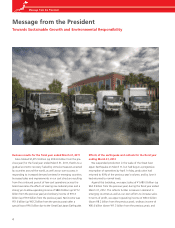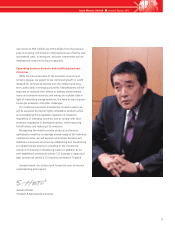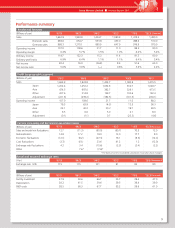Isuzu 2011 Annual Report Download - page 12
Download and view the complete annual report
Please find page 12 of the 2011 Isuzu annual report below. You can navigate through the pages in the report by either clicking on the pages listed below, or by using the keyword search tool below to find specific information within the annual report.
10
The impact on the areas worst affected by the Great East Japan Earthquake which
struck on March 11, 2011 exceeded all expectations, necessitating long-term aid and
recovery assistance for theses areas and their residents. Isuzu is committed to bringing
its full resources to bear to aid the transport of supplies to the affected areas.
Corporate Social Responsibility
Corporate Social Responsibility
Aiding the transport of supplies to areas affected by
the Great East Japan Earthquake
Prioritizing recovery assistance
Since the earthquake struck on March 11, Isuzu has given
top priority to assisting recovery efforts in affected areas. Isuzu
products have been hard at work in the response to the disaster,
including numerous disaster aid vehicles (used by Japan’s Self-
Defense Force and fi re departments), aid transport vehicles, and
diesel engines for use in construction machinery and generators.
We will strive to provide a stable supply of parts and repair
service in support of these operations.
Assisting in the repair of water-damaged vehicles
Numerous trucks suffered water damage due to partial
or complete submersion in areas struck by the tsunami that
followed the Great East Japan Earthquake. Isuzu’s water-damaged
vehicle repair assistance activities have facilitated the timely and
dependable repair of these vehicles so that they can return to
service in affected areas.
On March 27, the entire development team at the Fujisawa
Plant began investigating four vehicles that had been shipped
to the plant from the disaster area after being damaged by the
tsunami. Water had risen as high as the driver’s seat, fouling the
vehicles with large amounts of contaminants and causing water
to accumulate inside the vehicles’ engines. Together with this
damage, the corrosion of wiring and connectors by seawater
was a testament to the extent of the disaster.
In just one week, the Isuzu team disassembled all vehicle
parts, investigated the damage, considered possible repair
methods, restored and repaired the vehicles using those
methods, and verifi ed proper operation on a test course. At the
same time, they conducted testing to reproduce the effects of
submersion, checking how, where, and to what extent water
got into the vehicles, and identifying which parts needed to be
repaired. As a result, they were able to complete a Repair Manual
at the same time as the vehicle restoration work was fi nished.
Service shops at sales companies in Iwate and Miyagi
began repairing actual water-damaged vehicles using the Repair
Manual on April 18. Even as they hurried to check problems
and resolve them so that the vehicles could be returned to
their owners as soon as possible, employees carried out their
work with care and caution to ensure the vehicles could be
operated in a safe manner well into the future. Procuring the
parts needed to make repairs proved to be a major diffi culty. More
than 1,700 parts had been identifi ed in advance as necessary for
the repairs, and workers had no choice but to use parts tagged
for production when no repair parts were available, and then
to resort to prototype parts when there was no inventory of
Actual water–damaged vehicle Repairing vehicles using the “Repair Manual”
























